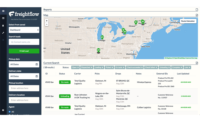Study: Industry Needs Better Transportation Management, Optimization

According to a recent survey of more than 400 logistics managers questioned by U.S. Xpress Enterprises, Chattanooga, Tenn., only 59% of shippers use performance metrics to manage freight costs and only 43% are currently running or planning to implement a transportation management system (TMS). The survey, which was conducted in conjunction with Peerless Research Group, Framingham, Mass., also shows a strong preference for dynamic optimization with nearly three-fourths of all shippers preferring that their carriers use present, actual shipping data rather than historic data to set their rates, with less than 1 in 5 favoring the use of historic or static data.
In terms of shipping timeframes, the survey confirmed the industry’s interest in just-in-time shipping, with 41% booking freight one day in advance and more than four in five scheduling three or fewer days ahead. The top strategies shippers use for controlling freight costs are consolidating shipments (60%), improving decision making and planning utilizing reporting (58%), working with fewer partners (53%), optimizing internal resources (52%), implementing or planning TMS (39%), adopting KPIs for carriers (38%) and working with more carriers (33%).
The survey shows that only around 4 out of 10 shippers are currently using any tool(s) to assess shipping costs, relying instead on less sophisticated methods to gauge their shipping costs. Among the 59% of carriers evaluating their freight costs, the most common aspects of shipping being measured are spend by carrier (74%), cost by route (72%), on-time performance (68%), spend by shipment volume (66%) and cycle time and carrier capacity (32% each).
The study also outlines that many of those using a transportation management system are happy with it, and 21% indicate that they are using these tools to their fullest advantage and for multiple initiatives, from tracking and tracing and load and route optimization, to provide mode selection and real time tracking. The study also showed that shippers are continually seeking to advance their operations. Areas earmarked for improvement are load optimization such as consolidation, backhauls, etc. (44%), electronic communication such as EDI, XML (44%), billing and invoicing (39%), reporting capabilities (37%) and integration of logistics and transportation applications with other enterprise apps such as ERP, WMS, etc. (34%).
Data sharing and supply chain visibility is another critical factor. While nearly one-half of respondents think their organization has sufficient ability to share and exchange information with customers and suppliers, almost one out of five rate their company unfavorable in this area.
“The survey demonstrates that there is great variance among shippers in terms of the level of technology they employ in doing freight optimization,” says John White, executive vice president of sales and marketing for U.S. Xpress Enterprises. “However, regardless of what systems they are currently using, it is clear that more widespread and efficient use of transportation management systems, clearer supply chain visibility, improved analytics, enhanced cooperation and data sharing between carriers and shippers and more up-to-date data could go a long way toward optimizing loads and reducing costs for everyone involved. It is critical for carriers and shippers to work together to find mutually beneficial solutions.”
Looking for a reprint of this article?
From high-res PDFs to custom plaques, order your copy today!







